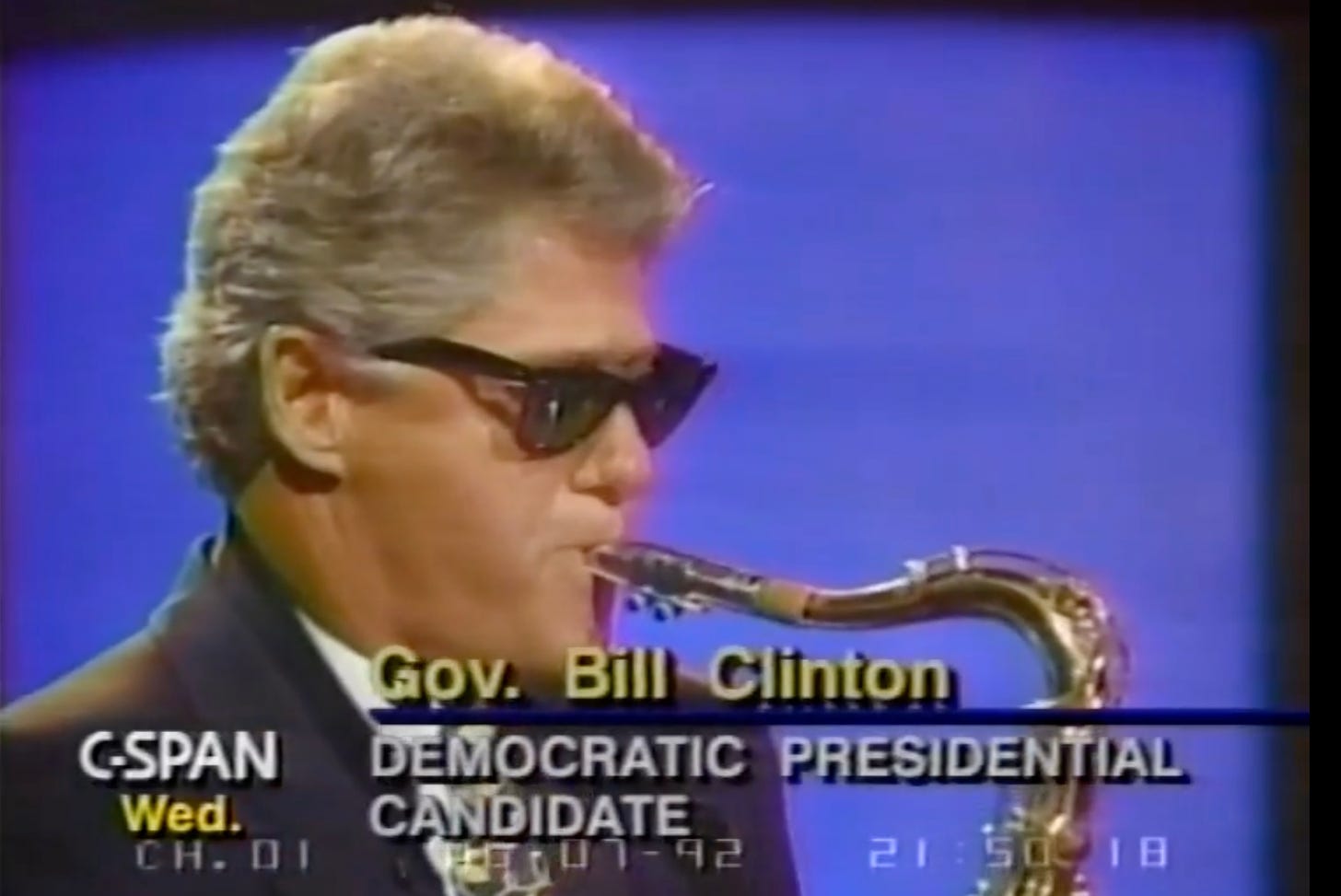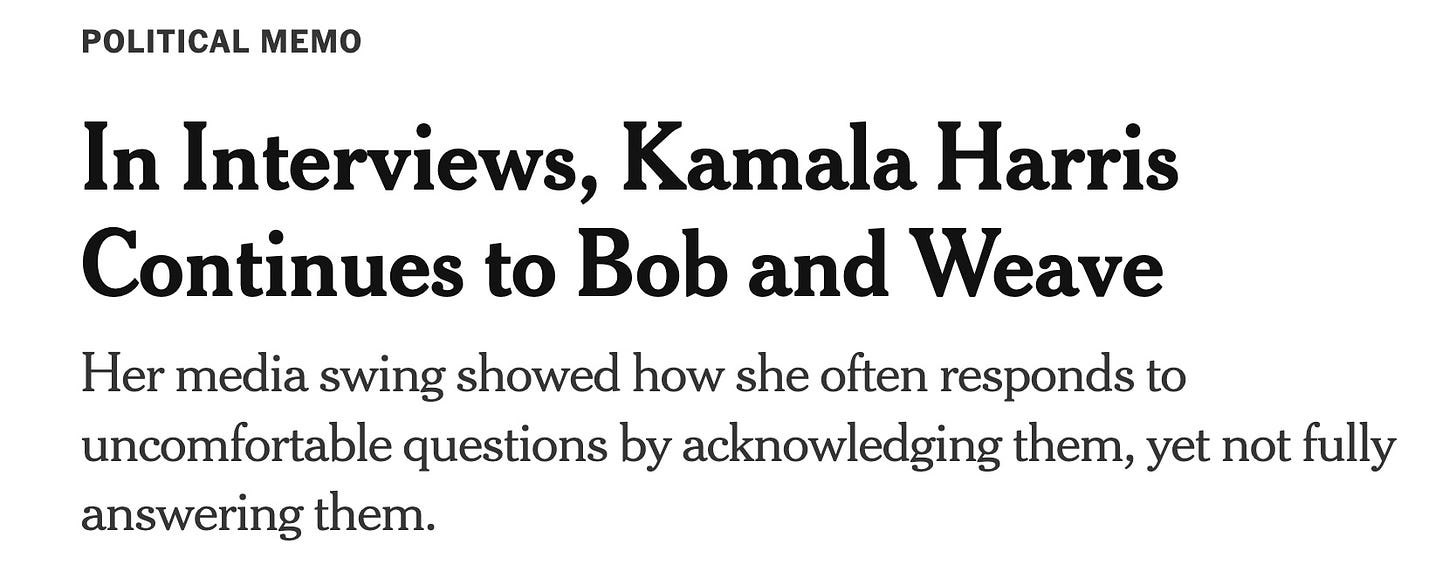Election Countdown, 25 Days to Go: Delivering the Message, Despite the Media.
What John Boyd's 'OODA Loop' tells us about the Harris campaign.
In early June, 1992, five months before the election, the young governor of Arkansas, Bill Clinton, was a distant third place in presidential polling, behind incumbent George HW Bush and independent Ross Perot. Part of Clinton’s comeback involved end-running traditional media coverage, with appearances like this saxophone-playing spot on the then-popular Arsenio Hall TV talk show. (Screen shot from C-Span.)
This post is about a media version of the OODA Loop, an idea that I wrote about more than 40 years ago in a book called National Defense. The acronym is pronounced to rhyme with Buddha, and it stands for “Observe, Orient, Decide, Act.” More details below.1
The OODA Loop concept, generally attributed to an Air Force fighter pilot named John Boyd, boiled down to the maxim that whichever side in a conflict could recognize and adapt to changed circumstances more quickly than the opponent, would come out on top. John Boyd originally based this on observation of aerial warfare in Korea, but he extended it to land combat, guerrilla battles, business strategies, industrial policies, sporting contests2, and most other arenas of competition.
Let’s apply it to the ever-changing landscape of “messaging” during a presidential campaign, particularly the wave of talk show and podcast appearances Kamala Harris has made in the past week.
Falling behind the OODA loop: ‘Why is she dodging the press?’
Many figures in the established media keep scolding Kamala Harris for “dodging” or “avoiding” formal press conferences or sit-downs with reporters and editorial boards. They act as if this is both a lapse in civic duty and a “tell” about her insecurity or unreadiness to face the “hard” questions that mainstream reporters would presumably ask.
For details of this grudging attitude, see below3. Two main examples were in Politico early this week, which previewed Harris’s media plans as a way to avoid talking about “issues,” and this all-too-typical headline and subhead in the New York Times about the appearances she made.
One obvious note about this Times story is that it appeared even as the paper’s editorial board was endorsing Harris as “the only patriotic choice” for president. (While making sure to criticize her in that same editorial for being “shielded” from press questions.) The more important point about this headline and sub-head, or ‘hed and dek,’ is that they gave a very different impression from the story itself.
The hed and dek are pure snark: Kamala Harris is afraid to face tough questions (or sit down with our reporters), and we’re not going to let anyone forget it! And, given constraints of time, that snarky framing is all that most of the Times’s audience will ever take from this story. One more strike against an “unready” candidate. One more reason to think “we don’t know enough about her.”
But anyone who happened to read beyond the headline would have a big surprise in store. That is because the article presents the bob-and-weave—more formally, “giving the answer you want to give, whether or not it’s the question you were asked”—less as a failing than as a time-honored political skill. Indeed, the article as a whole is quite respectful of Harris as an interviewee. For instance:
Ms. Harris, 59, can turn the typically defensive crouch of a non-answer into a bit of verbal jujitsu, as she did in declining the opportunity to identify Mr. Netanyahu as an ally. She can nimbly field a query and quickly lace her reply with trip wire for her opponent, as she did last month in her debate with former President Donald J. Trump.
Who offered this historically-grounded perspective? That is a question we can answer, because a name is in the byline. The story is by a Times reporter named Michael C. Bender. But who chose the headline? The subhead? The presentation that changed its tone from skill to snark? Who decided on the impression the story will leave on most people scanning through the paper’s site? That we don’t know. The relevant names aren’t on the story. And—remind me if you’ve heard this before—in the absence of a Public Editor, there’s no one who has the standing to get explanations about how the paper chose to frame the news this way.
Now, back to the media OODA Loop.
Getting ahead in the OODA Loop: Using different media.
John Boyd, whose partisan political views I never asked about or discussed, died in 1997 so was not around for the Trump era in presidential politics. But if he looked at grousing from the established media, and this past week’s new-media onslaught from Kamala Harris, I think he would say: She’s ahead of the cycle. And they are behind.
I’m doing more than guessing here. Back in the early 1990s I remember talking with John Boyd about the political agility of that era’s phenom, the young “new Democrat” candidate from Arkansas, Bill Clinton. We discussed the way Clinton would shine at “town hall” meetings or small-scale encounters with student groups—or teachers, factory workers, small business owners, regular citizens—and talk about what government meant in their lives, as distinct from politics.
Clinton was a consummate master of all things political. But part of his mastery was understanding that most Americans cared more about the real-world effects of government and governance—schools, hospitals, downtowns and parks, payroll and pensions, grandparents and grandchildren, peace and war—than they did about horse-race or polls. So while he dealt with the “regular” press, and was good at it, he did everything he could to reach beyond and around the press to get his ideas, his ambitions, his sensibility across.
Clinton was not the first one to make this discovery. A crucial step in Jimmy Carter’s out-of-nowhere path to the presidency was coming to the notice of renegade writer Hunter S. Thompson. By chance Thompson had been present for the breakthrough speech of Carter’s national career, his “Law Day” address in Georgia in 1974. (More precisely: the speech that became the breakthrough event for Carter, because Thompson happened to be present.) And as Carter was rolling toward the nomination in 1976, the then-hugely influential Thompson wrote this about Carter in the then-hugely influential Rolling Stone:
I have heard hundreds of speeches by all kinds of candidates and politicians – usually against my will and for generally the same reasons I got trapped into hearing this one – but I have never heard a sustained piece of political oratory that impressed me any more than the speech Jimmy Carter made on that Saturday afternoon in May 1974.
It ran about 45 minutes, climbing through five very distinct gear changes while the audience muttered uneasily and raised their eyebrows at each other, and one of the most remarkable things about the speech is that it is such a rare piece of oratorical artwork that it remains vastly impressive, even if you don’t necessarily believe Carter was sincere and truthful in all the things he said.
This one Hunter S. Thompson article didn’t make Jimmy Carter president. But it made a difference. Bill Clinton’s saxophone-playing appearance on Arsenio Hall didn’t make him president. But it helped.
Kamala Harris’s near-dozen media appearances this past week may not make her president. But they have given voters a much clearer sense of who she is, what she values, how she thinks, how she expresses herself, and what it would be like to have her in charge than a million shouted questions at a “press gaggle” or several dozen sober “why have you changed your mind on [issue xxx]?” interrogations on a Sunday show.
The ‘Daddy gang’ hears about policy. (With thanks to Joan Walsh.)
Over the past week, I’ve listened to (and made Otter.ai transcriptions) of nearly all of these “informal” appearances by Harris. Call Her Daddy and 60 Minutes. Colbert and The View. Stephanie Ruhle and Howard Stern and Univision and more. And I was going to do a compare-and-contrast of all of them.
But I have discovered that I don’t need to! Because today in The Nation, Joan Walsh has done exactly this compare-and-contrast. I very strongly recommend her piece. It is rich, detailed, and excellent. I’m not generally a fan of “letter-grade” articles, but I agree with Walsh’s assessments: That the worst of the week’s questioners was the most established and conventional (and intrusive), Bill Whitaker on 60 Minutes. That Stephen Colbert was predictably excellent in mixing humor with substantive questioning. And that the most valuable and revealing session overall was the hour Harris spent with Alex Cooper, on the Call Her Daddy podcast. All of the appearances, and especially Daddy, were OODA maneuvering of a high order.
I am not exactly what you’d call the heart of the Daddy demographic. The podcast is aimed at young women—the millions who are part of “the Daddy gang.” But Kamala Harris sounded completely comfortable and at ease with Cooper, who is a rough contemporary of Harris’s many next-generation relatives. I found it very much worth listening to.
A sample from Joan Walsh’s piece about this podcast:
Alex Cooper conducted the best interview, in my view, one that combined substance and emotion. She and Harris had a conversation that centered women… But Cooper also asked hard questions about what Harris’s economic policies will do for Gen X and millennials, who are “disincentivized to vote because politicians are essentially like over-promising, under-delivering.”…
Maybe the most policy-rich but also personal exchange came when Cooper noted: “Almost one in four Gen Z and millennials say they don’t want to have kids because it’s too damn expensive. How are you going to help young people not feel left behind?”
That let Harris lay out her $6,000 infant tax credit, her first-time homebuyer subsidies, her plan to use tax credits to get builders to build more homes. She also noted that the Biden administration has forgiven “student loan debt for millions of people by this point, I think over 5 million, including doubling the amount of student loan forgiveness for public servants like nurses and teachers and firefighters.”
Cooper didn’t push Harris about Israel, or nag her about how she’ll pay for her programs. That will make some journalists dismiss the conversation as shallow. But young women are among Harris’s most important voting blocs. They heard a rare hour of conversation centered on them, featuring the most powerful woman in the country. That matters.
All of these matter. John Boyd would be impressed.
‘Succession’: The JD Vance edition.
Here is a marker of another change in these past few days.





